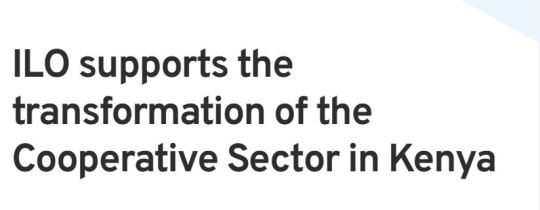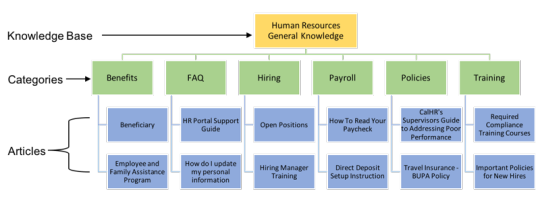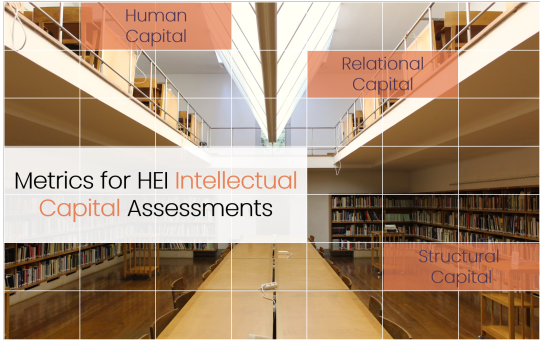#Knowledge Management
Text
Kinda wanna be a knowledge management specialist and essentially be a freelance digital organizer.
Maybe then I never have to deal with the public again
3 notes
·
View notes
Text
Knowledge Management
“Knowledge itself is power”
Knowledge management (KM) “is the process of creating, sharing, using and managing the knowledge and information of an organization. It refers to a multidisciplinary approach to achieve organisational objectives by making the best use of knowledge” (Wikipedia, 2020).
Questions for the Healthcare Team or Organisation
How is knowledge captured? Is anything missed?How…

View On WordPress
1 note
·
View note
Text
Strengthen the Cooperative sector to promote social solidarity for economic growth.

In line with the ILO’s Promotion of Cooperatives Recommendation, 2022 (No.193), Kenya recognizes the role of cooperatives in jobs creation, resource mobilization and socio- economic contribution to the nation’s development. The Government of Kenya’s social and economic plan dubbed the Bottom-Up Economic Transformation Agenda- (BETA) has placed cooperatives at the centre of its development plan.
BETA identifies cooperatives as an enabler that can facilitate positive changes at the bottom of the pyramid. Cooperatives cannot only drive organization of producers and aggregate production at the primary level but can also be used to promote access to markets, Business Development Services, financial services, social protection among other services. Over the years the cooperative sector in Kenya has lost its competitiveness due to changes in the business environment, governance challenges, advancement in technologies, and the decreasing returns to the agriculture sector among other challenges. To enable cooperatives to anchor its development plan, the Government has embarked on a cooperative sector transformation journey to improve the sector’s productivity, efficiency, and accountability.
The ILO, through the Partnership to Improve Prospects for Forcibly Displaced Persons and Host Communities programme (PROSPECTS) has been providing technical support to the Government to develop the Kenya Cooperatives Transformation Strategy (KCTS). A sector stakeholder consultative meeting was held in August 2023 to align the sector priorities to the BETA, and to prioritize issues that needed to be addressed in the transformation. Further sector consultations at grassroot level were held to gain buy in and provide room for public participation as required by law.
From 22-31 January 2024, ILO supported the organization of a final workshop that brought together key Government departments including the State Department of Cooperatives, the Presidential Economic Transformation Secretariat (PETS), the Cooperatives University of Kenya, the Attorney General’s Office, the Kenya Law Reforms Commission (KLRC), the Council of Governors, Cooperatives Alliance of Kenya, and the SACCO Society Regulatory Authority (SASRA). The objective was to finalize the drafting of the Kenya Cooperative Transformation Strategy. During the workshop, the following 11 key pillars were identified to enable the cooperative transformation agenda in Kenya: -
Pillar 1: Policy, Legal, Regulatory, and Institutional Framework, which focuses on establishing a robust foundation for cooperative development by formulating and implementing effective policies, legal structures, regulatory frameworks, and institutions.
Pillar 2: Cooperatives Compliance, which emphasizes the importance of compliance with established regulations and policies, encouraging cooperatives to adhere to cooperative principles and legal standards.
Pillar 3: Cooperative Governance which involves mechanisms for democratic decision-making, ensuring fair representation, and establishing accountability mechanisms to enhance the overall governance of cooperatives.
Pillar 4: Cooperative Productivity, Value Addition, and Market Access, which focuses on enhancing the economic viability of cooperatives through strategies to improve productivity, add value to products and services, and facilitate market access, ultimately contributing to the economic success of the cooperative enterprise.
Pillar 5: Cooperative Training, Information, and Research, which includes building the capacity of cooperative members and stakeholders through training, information dissemination, and research for informed decision-making and continuous improvement of the sector.
Pillar 6: Cooperative Knowledge Management which puts emphasis on the systematic organization and utilization of knowledge within cooperatives. It involves the creation of knowledge-sharing platforms, documentation of best practices, and fostering a culture of learning and innovation to enhance the overall knowledge base of the cooperative community.
Pillar 7: Cooperative Financing and Investment which addresses the financial aspects of cooperative development, including mechanisms for raising funds, managing finances effectively, and promoting responsible investment practices to ensure the financial sustainability of cooperative enterprises.
Pillar 8: Information, Technology and Digitization which explores the integration of Information and Communication Technologies (ICT) and other innovative technologies within the cooperative sector. This pillar aims to enhance efficiency, connectivity, and competitiveness through the adoption of modern technologies.
Pillar 9: Inter-Linkages and Coordination with Strategic Partners which underscores the importance of collaboration and coordination between cooperatives and various strategic partners.
Pillar 10: Cooperative Communication which focuses on promoting collaboration, transparency, and unity among members, stakeholders, and the broader community for social solidarity.
Pillar 11: Cross cutting Issues: Climate Change, Disaster Preparedness, Gender Inclusivity, Refugee Inclusion, Mainstreaming Youth, and PWDs, Peaceful Coexistence and wealth Distribution, which addresses key overarching concerns that have a profound impact on the cooperative sector.
The workshop also served to prioritize the transformation pillars and review the legal framework (Act and Regulations) that will enable the implementation of the strategy. As a next step the strategy, revised Cooperatives Bill and Regulations will be presented to the responsible parliamentary committee for enacting, before rolling out the implementation plan. The ILO will continue to provide technical assistance to Government to strengthen the Cooperative sector to promote social solidarity for economic growth.
#cooperatives#kenya#technical assistance#workshops#knowledge management#cooperative financing#cooperative productivity#cooperative governance#Cooperatives Compliance#cooperative development#cooperative transformation
0 notes
Text

Searching for relevant information or documents can be time-consuming and frustrating without a centralized knowledge management system.
A knowledge management solution serves as a centralized repository for storing a wide range of information, including documents, manuals, product guides, FAQs, and service expertise. This helps to break down knowledge silos and ensures that valuable insights are accessible to all reducing the turnaround time(TAT).
If your business is grappling with scattered knowledge and collaboration woes, let's transform your operations with ServitiumCRM Knowledge Management. Reach out to us for a personalized solution. Read More...
#knowledge management crm#knowledge management portal#knowledge management software#knowledge management system#knowledge management
0 notes
Text
Anthony Robbins: Crossroads
Tony Robbins – 140tc (Photo credit: Randy Stewart)
“You are now at a crossroads. Forget your past. Who are you now? Who have you decided you really are now? Don’t think about who you have been. Who are you now? Who have you decided to become? Make this decision consciously. Make it carefully. Make it powerfully. Then act upon it.”
—Anthony Robbins.

View On WordPress
#Anthony Robbins#Decision making#Decision Trees#Knowledge Creation#Knowledge Management#Oceania#Problem Solving#Tony Robbins
0 notes
Text
Ontology in Use: A Deep Dive into Semantic Relationships and Knowledge Management
In the realm of artificial intelligence and data science, ontology plays a pivotal role. It provides a structured framework that enables efficient knowledge management and data analysis. This article aims to shed light on the practical applications of ontology, with a focus on tools that support semantic relationships, such as RDF/RDFS and OWL.
Understanding Ontology
Ontology is a branch of philosophy that deals with the nature of being or reality. In the context of computer science and information technology, ontology refers to a formal representation of knowledge within a domain. It provides a framework for defining and organizing concepts and their relationships, thereby creating a shared understanding of a specific area of interest.
Tools Supporting Semantic Relationships
There are numerous tools available that support semantic relationships, particularly those defined by RDF/RDFS and OWL. RDF (Resource Description Framework) and RDFS (RDF Schema) provide a foundation for processing metadata and represent information on the web. OWL (Web Ontology Language), on the other hand, is designed to represent rich and complex knowledge about things, groups of things, and relations between things.
Some of the notable tools that support RDF/RDFS and OWL include:
Protégé: A free, open-source ontology editor and framework for building intelligent systems. Protégé fully supports the latest OWL 2 Web Ontology Language and RDF specifications from the World Wide Web Consortium.
Apache Jena: A free and open-source Java framework for building Semantic Web and Linked Data applications. It provides an RDF API to interact with the core API to create and read Resource Description Framework (RDF) graphs.
OpenLink Virtuoso: A comprehensive platform that includes a reasoner, triple store, RDFS reasoner, OWL reasoner, RDF generator, SPARQL endpoint, and RDB2RDF.
RDFLib: A Python library for working with RDF. It contains parsers and serializers for RDF/XML, N3, NTriples, N-Quads, Turtle, TriX, Trig, and JSON-LD.
YAGO: A Practical Application of Ontology
YAGO (Yet Another Great Ontology) is a prime example of ontology in use. It's a knowledge base that contains information about the real world, including entities such as movies, people, cities, countries, and relations between these entities. YAGO arranges its entities into classes and these classes are arranged in a taxonomy. For example, Elvis Presley belongs to the class of people, Paris belongs to the class of cities, and so on.
What makes YAGO special is that it combines two great resources: Wikidata and schema.org. Wikidata is the largest general-purpose knowledge base on the Semantic Web, while schema.org is a standard ontology of classes and relations. YAGO combines these two resources, thus getting the best from both worlds: a huge repository of facts, together with an ontology that is simple and used as a standard by a large community.
The Future of Ontology
The future of ontology looks promising. With the rise of artificial intelligence and machine learning, the need for structured and semantically rich data is more critical than ever. Ontology provides a way to structure this data in a meaningful way, enabling machines to understand and reason about the world in a similar way to humans.
In conclusion, ontology plays a crucial role in knowledge management and data analysis. It provides a structured framework for defining and organizing concepts and their relationships, thereby creating a shared understanding of a specific area of interest. The practical applications of ontology, such as YAGO, demonstrate the power and potential of this approach. As we continue to advance in the field of artificial intelligence, the importance and use of ontology will undoubtedly continue to grow.
1 note
·
View note
Text
Evolutionary model of knowledge management
Towards the end of last year, I wrote about the challenges in deploying digital technologies in holistic approaches to knowledge management in order to gain organizational value and competitive advantage [see ‘Opportunities lost in knowledge management using digital technology’ on October 25th, 2023]. Almost on the last working day of 2023, we had an article published in PLOS ONE (my first in…

View On WordPress
1 note
·
View note
Text
Why we need to have a digital knowledge management system!
I can't and shant tell the answer more beautifully than the way Mr. Ray Dailo has written in his book "THE WORLD CHANGING ORDER".
The human player is more intentive, more lateral in thinking, and better able to reason, while the computer calculate more data faster, is better able to identify patterns, and is much less emotional
0 notes
Text
"I am going to get a good grade in ___________, a thing that is both normal to want and possible to achieve" drifts through my brain with positively alarming regularity.
#this is because I managed to have an interesting conversation with my uncles at dinner#and also I had Work Stuff to do in front of my mother and felt so so proud of myself#sometimes being human is very ridiculous.#celestial emporium of benevolent knowledge
10K notes
·
View notes
Text
A full-stack open-source versatile graph knowledge management webapp, inspired by Notion and infinite outliners like Worflowy/Roam/Logseq. Coming in Q1 2024.
Built with XTDB, shadow-grove, SCI & more.
The primary motivation was to combine Notion’s database and document editing experience with the structural flexibility of infinite outliners (apps like Workflowy or Logseq). The broader vision for Brimm is to provide you with a capable personal/team graph database with a default UI.
Brimm lets you model data as blocks of many shapes (text, tasks, bookmarks, personal info, events, books, music albums, contact info, etc.), categorise and organise it, make connections, and search across it. You can "mirror" blocks elsewhere, create live queries rendered e.g. in a table, .. .
The core data model is "graph of nodes [blocks] with properties" [such as a date, tags picker, ...]. You can mould your data and workflows using Clojure through SCI - derive new facts, write a script to import external facts, ... .
0 notes
Text
Empowering Minds Globally: Unraveling the World of Calculations with 'How Do I
In a world where knowledge is power, the pursuit of understanding complex calculations can be a formidable challenge. Enter "How Do I" – your go-to platform for delving deep into a myriad of calculation topics spanning Mathematics, Physics, Chemistry, Computer Science, and beyond. With a mission to demystify complexity and make knowledge accessible globally, "How Do I" stands as a beacon of empowerment for individuals seeking clarity in the often intricate realms of academia.
Breaking Down Language Barriers: One of the unique features that sets "How Do I" apart is its commitment to breaking down language barriers. With content presented in a staggering 78 languages, the platform transcends geographical and linguistic boundaries. This inclusivity empowers individuals worldwide to explore and unravel the intricacies of calculations, fostering a sense of unity in the pursuit of knowledge.
A Comprehensive Approach: "How Do I" takes a comprehensive approach to education, catering to both students in need of academic support and curious minds eager to explore the world of calculations. The platform covers a vast array of subjects, ensuring that no topic is too niche or too broad for those seeking answers. Whether you're grappling with mathematical equations, navigating the principles of physics, deciphering chemical reactions, or diving into the complexities of computer science, "How Do I" is here to simplify, educate, and inspire.
Simplifying Complexity: The heart of "How Do I" lies in its dedication to simplifying complexity. Complex calculations can often feel overwhelming, but this platform strives to make them approachable and understandable. By breaking down concepts into digestible pieces, employing clear explanations, and providing step-by-step guides, "How Do I" empowers learners to tackle even the most challenging topics with confidence.
Journey of Discovery: Embark on a journey of discovery with "How Do I" as your guide. The platform invites users to explore the world of calculations with a sense of curiosity and wonder. Whether you're a student navigating the demands of academia or an inquisitive mind eager to expand your understanding, "How Do I" invites you to say, "How Do I?" with confidence.
Conclusion: In a world where knowledge knows no bounds, "How Do I" emerges as a beacon of empowerment, connecting individuals from diverse backgrounds through the universal language of learning. By simplifying complexity, breaking down language barriers, and fostering a global community of learners, this platform invites everyone to join the journey of unraveling the world of calculations. Say "How Do I?" with confidence, and let the exploration begin.
#How Do I#language learning#language blog#knowledge is power#knowledge fight#knowledge sharing#multiple choice#knowledge management#platform boots#platform heels#unlock#Calculations
1 note
·
View note
Text
Mastery Series: Elevate Your HR Service Delivery with ServiceNow Knowledge Management
Discover the power of ServiceNow HRSD Knowledge Management with this comprehensive guide. Learn how to streamline HR processes, enhance employee experience, and ensure compliance through documentation, SOPs, governance, and practical implementation tips.
Building a Strong Foundation: Essential Prework for ServiceNow HRSD Knowledge Management
Before you begin implementing ServiceNow HRSD Knowledge Management, it’s advisable to review the resources provided by ServiceNow to ensure a solid foundation for success.
Here’s a review of the format and content of the resources mentioned:
1. Getting Started with Knowledge Management
This resource is a…

View On WordPress
#Employee Experience#Governance#HR Documentation#HRSD#Knowledge Base Optimization#Knowledge Management#Performance Metrics#ServiceNow#ServiceNow HRSD#SOP Best Practices
0 notes
Text
Metrics for HEI Intellectual Capital Assessments
In Higher Education Institutions (HEIs), gauging Intellectual Capital (IC) isn’t just essential—it’s imperative. Simply tallying publications or leaning on generic commendations barely scratches the surface. A deeper exploration into the alchemy of intellectual capital creation is essential because it empowers HEIs to create an additional revenue stream and dominate their domain.
Deciphering…

View On WordPress
#Academic Excellence#Academic Innovation#Assessment Methodology#Deciphering Intellectual Capital#HEI Evaluation#Higher Education Metrics#Human Capital#Improved Stakeholder Engagement#Institutional Supremacy#Intellectual Capital#Knowledge Management#Relational Capital#Structural Capital#Tangible Benefits
0 notes
Text
Taming my information consumption
Is it futile to tame the deluge of information? Well, I'm trying anyway by simplifying, streamlining and yes, deleting stuff.
My system hinges on #RSS and hopes to capture them into #Obsidian
#Blogs #Substack #Reading #Reads #Newsletters #PKM
I’m an information junkie. If my recent foray and obsession about geopolitics isn’t a clue, I also tend to get obsessive about certain topics, which will lead me to consume every video, essay and podcast about the topic. This weird ability to absorb massive amounts of information at one go has aided me in my career, especially when I had to transition to a totally new field.
However, it isn’t…

View On WordPress
0 notes
Text

An authentic outlook on what burnout really is..
Try the 🌎's only self-maintaining and fully integrated AI knowledge tool https://knowledgedrive.com
1 note
·
View note
Text
Opportunities lost in knowledge management using digital technology
Regular readers of this blog will know that I occasionally feature publications from my research group. The most recent was ‘Predicting release rates of hydrogen from stainless steel’ on September 13th, 2023 and before that ‘Label-free real-tracking of individual bacterium’ on January 25th 2023 and ‘A thermal emissions-based real-time monitoring system for in situ detection of cracks’ in ‘Seeing…

View On WordPress
#artificial intelligence#creativity#digital twin#integrated digital environment#knowledge#knowledge management#machine learning#MyResearch#nuclear energy#PhD#power stations#regulation#research#safety case#validation
0 notes